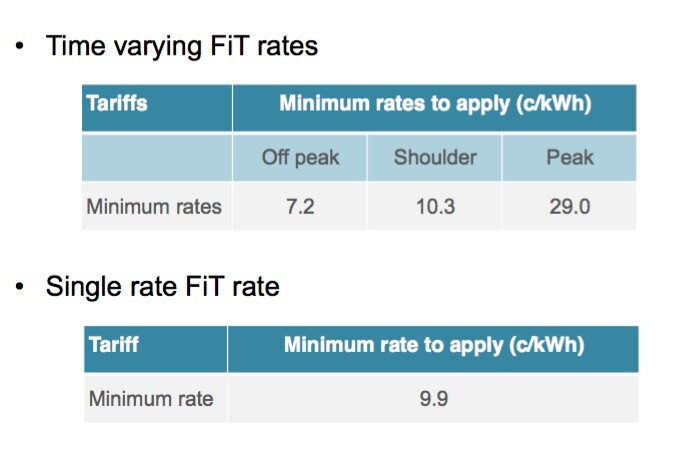The Victorian Essential Services Commission (ESC) has proposed a variable-rate feed-in tariff for solar & battery system owners in the state. A draft decision from the ESC on the matter puts the state’s minimum solar feed-in rate (for off-peak periods) at 7.2 cents per kilowatt-hour (7.2c/kWh), while households exporting solar to the grid at peak times could earn as much as 29c/kWh. Electricity retailers could also offer a conventional flat-rate FiT at a proposed rate of 9.9c/kWh. The new rate schemes – which may be modified between the draft and final reports – will go into effect from 1 July 2018.
Compare Solar & Battery Quotes
What the new FiT rates mean for Victoria’s solar households
The concept of a variable rate solar feed-in tariff itself is not a new one in Australia – now defunct electricity retailer Urth Energy offered a FiT based on the half-hourly wholesale price of electricity on the National Electricity Market, but the program was completely voluntary and only available to Urth Energy customers. The Victorian regulator’s proposal is still groundbreaking in that it is a government-backed framework with mandatory minimum rates.
The ‘time varying FiT rates’ will be paid out in accordance to the schedule in the table below. For all practical purposes, the ‘off-peak’ rate will only rarely apply, as the earliest the sun rises in Victoria is just before 6am and the latest it sets is about 8:30pm (summer solstice). ‘Shoulder’ rate payments are likely to be the most common, as the 7am-3pm period a) covering the highest solar production period of the day (about 11am-2pm), and b) being the time that most households are unoccupied and therefore not using much electricity.
Here’s what you need to know:
- Solar self-consumption – using your solar energy directly within your home – will remain the main way to save money with solar. For the most part, feed-in tariff rates continue to be a ‘sweetener’ for solar system owners, and not the main reason to install a system.
- Electricity companies will have the option to offer either the flat rate, variable rate or both rates to their solar customers. It’s unclear if electricity retailers will link the new FiT types to customers’ retail tariff types (i.e. time varying FiT for time-of-use customers, and flat-rate FiT for flat-rate customers) or if they’ll be more flexibile with plans, allowing solar households to pick and choose regardless of their retail tariff type.
- Solar households will be able to choose either the flat or variable rate FiT – although not they may have to switch retailer if their current company only offers one or the other.
- Solar households will still be able to shop around for higher rates & better overall deals using the Vic government’s Switch On comparator site, or other third party sites like WattEver.com.au.
- The proposed minimum flat rate of 9.9c/kWh is slightly less than the 11.3c/kWh minimum currently in place.
- There logic behind the variable rate FiT is that electricity is actually worth more on the grid later in the day – during ‘peak’ consumption periods. The 29c/kWh rate will act as an incentive for solar homes to send their solar energy (and possibly stored battery energy) into the grid when it is needed most, but when solar panels are past their production peak for the day (usually between 11am and 2pm) – and when it is generally least convenient for homes to avoid using power in the first place.
Flat or variable – which would you chose?
All things being equal – and assuming that switching between one or the other doesn’t necessitate a physical meter change – the variable-rate tariff seems to be the clear choice. The flat rate option is only 9.9c/kWh, 24 hours a day. Although the off peak rate under the variable FiT is only 7.2c/kWh, most of the off peak schedule is overnight (when solar panels won’t be generating electricity anyhow).
This means that the minimum a solar households on the variable plan can expect to get paid for their excess solar energy is 10.3c/kWh – but possibly as high as 29c/kWh. By comparison, the typical Victorian household pays about 26c/kWh for electricity they draw from the grid.
Interestingly, the variable rate opens the door for battery system owners to potentially ‘play the market’ by selling stored energy into the grid during peak times if it makes financial sense for them to do so – and provided they’ve got technology that enables such transactions in the first place.
No matter how you look at it, Victoria’s new variable rate FiT is one of the most significant developments on Australia’s solar feed-in tariff scene in years. It will be interesting to see how electricity retailers carry it forward as it becomes a fact of life from July next year – and how it impacts the economics of going solar in Victoria.
Compare Solar & Battery Quotes
- APsystems Battery Review: An Independent Assessment by Solar Choice - 18 December, 2025
- Running Cost of Air Conditioners – Explained - 7 October, 2025
- Air Conditioner Rebate South Australia: What You Need to Know - 19 September, 2025


If people with batteries all decide to export the part of their stored solar they don’t need into the grid at 3pm (when they get $0.29/kWh) then there will be a spike in export which may not be what the grid needs. There needs to be a mechanism to ensure that whatever is exported from 3pm to 9pm is done evenly.